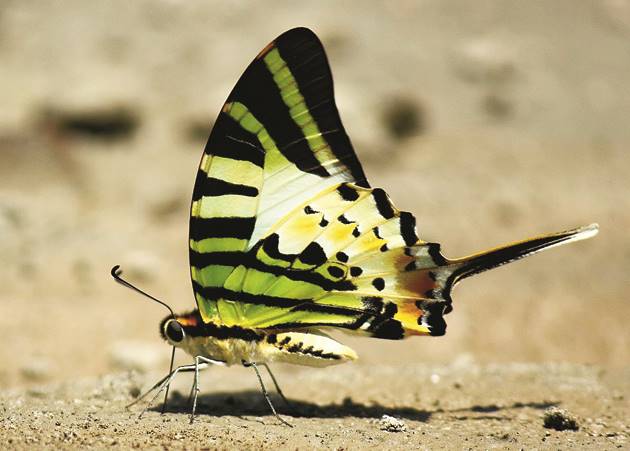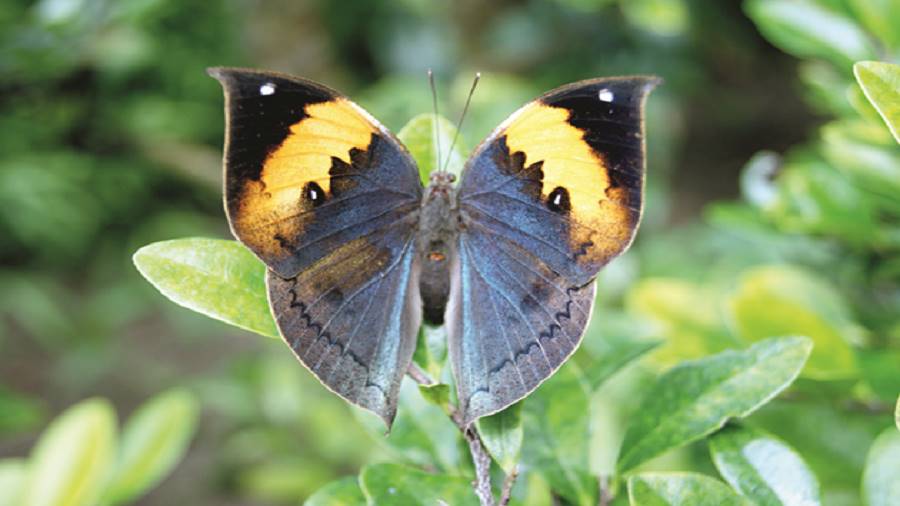Pete Vukusic, a scientist at the Exeter University in the UK, would be amused to learn that among the seven butterflies Indian citizens have shortlisted as probable candidates for the national butterfly, there is one named Krishna Peacock. Vukusic has spent his life unravelling the mysteries of its wings. He has not worked with the Krishna Peacock per se but with Morpho, whose wings share a common secret.
Morphos are celebrities, drawing thousands of tourists and butterfly lovers to the jungles of the Amazon basin. People aboard low-flying aircraft that are cruising just above the forest canopy often catch flashes of vivid blue and green. These are caused by Morpho butterflies, of which there are several species. Their wings dazzle when sunlight falls on them and the colour changes as the butterflies change their course. It is truly a mesmerising experience.

Yellow gorgon Sourced by the Telegraph
Closer home, if you take a leisurely walk along a river bank or a nearby jungle path in the foothills of eastern India, or spend a few lazy moments by a stream running down a hill in one of the Northeastern states or in the Western Ghats, you will find a Peacock. No, not the bird — or, perhaps, that too — but one of the many species of Peacock butterflies found in this country. While the upper part of the wings of a Morpho sparkle brilliantly, the Peacock has a relatively smaller such patch on its hind wings. But it dazzles just as much. Why? What makes them iridescent? Vukusic was intrigued by this puzzle.
Butterflies are adored for many reasons; one is surely the colours and patterns they carry on them. They are showy creatures. Scientists concluded long ago that butterflies have much larger wings than required for flight. There were even experiments that showed removal of the hind wings of certain butterflies had very little effect on their ability to fly. Removal of the front wings was, of course, debilitating. It is clear that wings are more than just the equipment butterflies use to fly. They are, partly, a show-off thing.

Common Jezebel Sourced by the Telegraph
Butterflies use colours to send a message. Colours confirm identities, they also help deceive. Butterflies find mates, keep vigilance on and ward off rivals, play tricks with a chasing predator — a bird perhaps — through the patterns and colours on their wings.
If you catch a butterfly, it will leave behind coloured dust from its wings on your fingertips. Under a microscope these particles will be revealed to be tiny flakes of colour, minute scales ranging in dimension from a few tens to a few hundred micrometres. A stalk at one end usually attaches the scale to the membrane of the wing, a thin, transparent sheet much like a sheet of cellophane. The scales get their colour from pigments impregnated in them. Rub the wings hard enough and you will be left with a sad, colourless creature. That, however, is not true for the Morpho and Peacock.
If a visitor comes across a Peacock butterfly while browsing old insect specimens in a museum, he or she will notice that even though time and rough handling have removed much of the scales and colour, a part of the wings still shimmer as if illuminated by a light from within.

Swordtail Sourced by the Telegraph
Vukusic took a closer look at the wings of a Morpho under an electron microscope and discovered that pigments play no role in their brilliance. The upper surface of the wings is sculpted in such a manner that instead of reflecting light, it diffracts it. The light breaks down into its component colours that interact with each other to produce the radiance. The phenomenon can be compared to the colours we see in a soap bubble or an oil slick on a wet road. The blue-green beauty of the Morpho comes from no colour pigment.
The structures on the wing surface look like parallel ridges running along its length. In a cross section, the ridges look like a Christmas tree in silhouette, boughs extending on both sides and shrinking in width towards the top. Through evolution down the ages, the great craftsman has gifted these wings the playfulness and power to manipulate light.
But Vukusic did not stop with this illuminating discovery. The colour visible after diffraction depends on the difference between the refractive indices of air (refractive index 1.0003) and the transparent wing. By tweaking these values, these same structures can produce a myriad colours. When Vukusic soaked the wings in acetone (refractive index 1.359), instead of blue, he saw brilliant green. Now he is working on ways to utilise this unique property in new types of sensors. If we want to monitor air and detect a specific vapour in it, the magic butterfly wings can show a way. As the composition of air changes, so does its refractive index. This in turn changes the colour emanating from the wing surface after diffraction. Colours as messages can then transcend the butterfly world and be used by man to monitor the environment.










